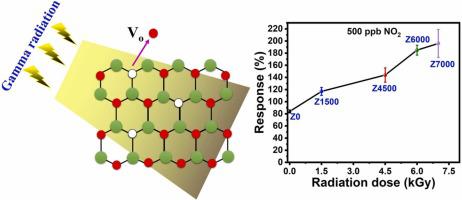Sensors and Actuators B: Chemical ( IF 8.0 ) Pub Date : 2022-06-21 , DOI: 10.1016/j.snb.2022.132255 Aswin kumar Anbalagan , Shivam Gupta , Rishi Ranjan Kumar , Anupam Ruturaj Tripathy , Mayur Chaudhary , Shu-Chih Haw , Thangapandian Murugesan , Heh-Nan Lin , Yu-Lun Chueh , Nyan-Hwa Tai , Chih-Hao Lee

|
Gamma-ray irradiation is a fast and efficient technique that can constructively create various defects in a controlled manner to tune materials’ functionality. In this work, zinc oxide nanorods are hydrothermally grown over flexible polyethylene terephthalate paper substrate and then irradiated with 60Co gamma-ray source to create various defects for possible enrichment towards NO2 gas sensing. The sensors irradiated with gamma-ray show enhanced NO2 responses of 120%, 160%, and 185% for 500 ppb concentration at the irradiation doses of 1.5 kGy, 4.5 kGy, and 6 kGy, respectively, as compared to the pristine sensor response of 80%. Maximum response of 312% is achieved at the irradiation dose of 6 kGy for 1500 ppb of NO2. Overall, this study confirms that the enhanced oxygen vacancies, defect concentration, and increased grain boundaries, caused by gamma-ray irradiation can eventually achieve more than two times better efficiency towards NO2 detection at room temperature (25 ℃) on a flexible based NO2 sensor.
中文翻译:

氧化锌纳米棒上的伽马射线工程表面缺陷可增强室温下的二氧化氮气体传感性能
伽马射线辐照是一种快速有效的技术,可以以受控方式建设性地产生各种缺陷,以调整材料的功能。在这项工作中,氧化锌纳米棒在柔性聚对苯二甲酸乙二醇酯纸基材上水热生长,然后用60 Co γ 射线源照射,以产生各种缺陷,从而可能富集 NO 2气体传感。与原始传感器响应相比,在 1.5 kGy、4.5 kGy 和 6 kGy 的辐射剂量下,用伽马射线照射的传感器在 500 ppb 浓度下的 NO 2响应分别提高了 120%、160% 和 185% 80%。对于 1500 ppb 的 NO 2,在 6 kGy 的辐照剂量下可实现 312% 的最大响应. 总体而言,这项研究证实,由伽马射线辐照引起的氧空位、缺陷浓度和晶界增加最终可以在室温(25 ℃)下在柔性基 NO 上实现两倍以上的 NO 2检测效率。 2传感器。











































 京公网安备 11010802027423号
京公网安备 11010802027423号